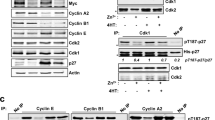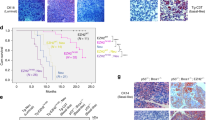Abstract
Induction of the Myc-oestrogen receptor fusion protein (MycER) by 4-OH-tamoxifen (OHT) leads to the activation of Cyclin E/Cyclin-dependent kinase 2 (CycE/Cdk2) complexes followed by the induction of DNA synthesis. As CycE/Cdk2 activity is essential for G1/S transition, we have investigated the mechanism by which Myc can activiate CycE/Cdk2. Our results suggest that this activation may involve at least two Myc-dependent steps: the induction of cyclin E gene transcription followed by accumulation of cyclin E mRNA in a protein synthesis-independent manner and the inhibition of p27Kip1 association with CycE/Cdk2 complexes containing newly synthesised CycE. As a consequence phosphorylation of CycE-bound Cdk2 by cyclin activating kinase (CAK) is accelerated. We propose a model in which the active newly synthesised CycE/Cdk2 complexes trigger a positive feed-back mechanism to activate preexisting complexes through phosphorylation-dependent p27Kip1 release.
This is a preview of subscription content, access via your institution
Access options
Subscribe to this journal
Receive 50 print issues and online access
$259.00 per year
only $5.18 per issue
Buy this article
- Purchase on Springer Link
- Instant access to full article PDF
Prices may be subject to local taxes which are calculated during checkout
Similar content being viewed by others
Author information
Authors and Affiliations
Rights and permissions
About this article
Cite this article
Pérez-Roger, I., Solomon, D., Sewing, A. et al. Myc activation of cyclin E/Cdk2 kinase involves induction of cyclin E gene transcription and inhibition of p27Kip1 binding to newly formed complexes. Oncogene 14, 2373–2381 (1997). https://doi.org/10.1038/sj.onc.1201197
Issue Date:
DOI: https://doi.org/10.1038/sj.onc.1201197
Keywords
This article is cited by
-
Non-canonical pathway for Rb inactivation and external signaling coordinate cell-cycle entry without CDK4/6 activity
Nature Communications (2023)
-
Cellular senescence in neuroblastoma
British Journal of Cancer (2022)
-
MYC: a multipurpose oncogene with prognostic and therapeutic implications in blood malignancies
Journal of Hematology & Oncology (2021)
-
Cisplatin exposure causes c-Myc-dependent resistance to CDK4/6 inhibition in HPV-negative head and neck squamous cell carcinoma
Cell Death & Disease (2019)
-
BET and Aurora Kinase A inhibitors synergize against MYCN-positive human glioblastoma cells
Cell Death & Disease (2019)



